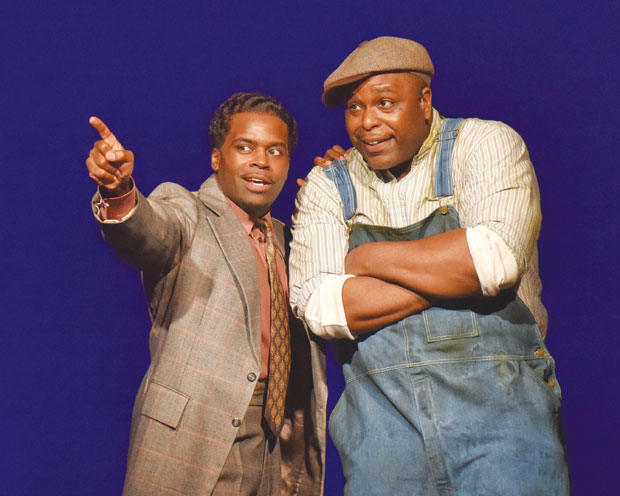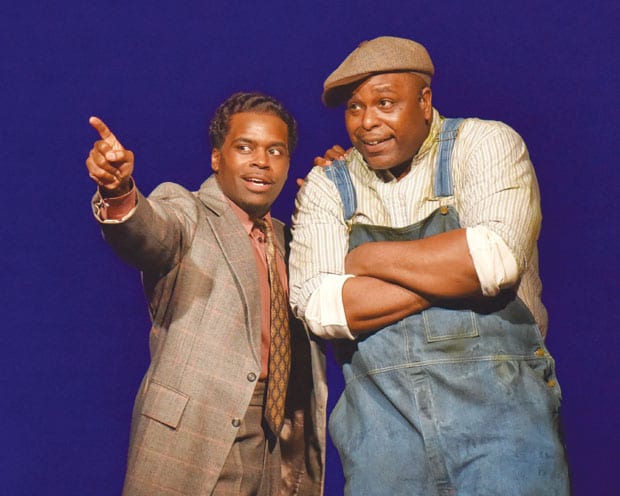
In the African-American community, the folk song “Stagger Lee” sits alongside “Frankie & Johnny” or “Bonnie and Clyde” as an iconic murder ballad: The story of a brutish thug (Stagger) who kills a man named Billy for stealing his Stetson. It’s been around more than a century, and everyone from Ma Rainey to Lloyd Price to Nick Cave has recorded a cover.
Its omnipresence across generations was the inspiration for playwright Will Power to use it as a jumping-off-point for his musical Stagger Lee, now getting its world premiere at the Wyly Theatre. Billy (Cedric Neal, pictured left) and his wife Delilah (Tiffany Mann) are the protagonists, a couple struggling to make a way for themselves but forever being kept down by everything from racism to their affiliation with Stagger (J. Bernard Calloway, pictured right), who Billy feels an affection for even as he sees how dangerous he is. The story follows the couple on their search for a better life, from their arrival in St. Louis in 1910 to the heyday of Harlem in the ’30s, Chicago in the 1950s, Oakland in the ’70s and Detroit in the ’80s. And that’s kind of the problem. Power has bitten off a huge chunk of history and tried to shoehorn it into a linear play: Chris, Delilah, Stagger and the rest never age or change; like The Simpsons or Lestat, they just show up in a different era with the same problems, at the same points in their lives.
The metaphor Power is looking for — that the travails of African-Americans are ongoing and destructive — is a valid one, but there’s no thrust to the story. It sometimes feels more like a travelogue than a rumination on race. (It’s also confusing occasionally because while the cast is African-American, they sometimes play white characters; it’s hard to figure out when they are supposed to be racists and when they are just being vindictive black people.) But while the gimmickry doesn’t quite work, everything else about Stagger Lee hits on all cylinders. This is an elaborate show, with a parade of well-designed sets and period costumes that conjure the eras they portray. It’s also a large cast of 23, led by the ethereal voice of Neal. Neal was a staple on North Texas musical stages before hitting it big on Broadway and London’s West End, and it’s a joy to experience his wailing tenor again. On song after song, he soars and takes us with him. Mann also impresses, as does the entire ensemble, whose standouts include M. Denise Lee and Akron Watson.
Power’s lyrics are sometimes not as well-honed as they could be, but the score (written with Justin Ellington) is rich with lovely numbers that director Patricia McGregor beautifully showcases. Stagger Lee has been a work-in-progress in Dallas for several years; it will surely continue to develop and evolve — that’s the nature of theater — but has the bones to be an excellent musical, poignant and lovely and meaningful.
The script for Sexy Laundry at WaterTower’s Studio Theatre is less edgy than Stagger Lee, but audiences may still find it cuts to the quick with its observations about relationships. Alice (Wendy Welch) and Henry (Bob Hess) have been married 25 years, and are in a rut. Alice organizes a weekend together at a schmancy hotel where they can engage in sexercises meant to revive the spark — what are each others’ fantasies? How can we put some zing back in the bedroom? Of course, nothing goes as planned.
This premise has been around at least since the 1960s (Neil Simon’s Plaza Suite devotes one act to it), and at first, Sexy Laundry feels safe and derivative, even though it manages a fair share of clever one-liners (which, in part, remind you further of Neil Simon). But author Michele Riml offers up some pretty canny insights into the complexities of any longterm relationship (gay as well as straight), and there’s a lot of nodding by audience members. The production also has two secret weapons: Hess and Welch, two masters of thoughtful romantic comedies who can turn the most humdrum situations into comic gems.
— A.W.J.
This article appeared in the Dallas Voice print edition February 6, 2015.


















